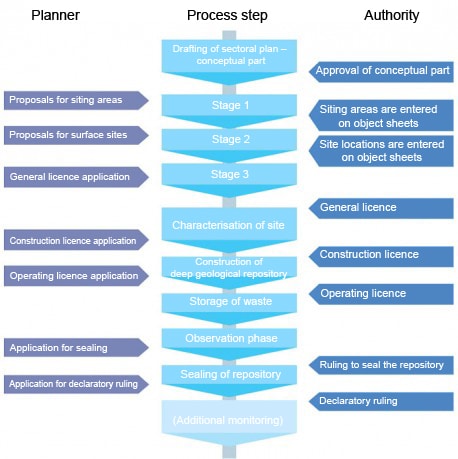According to the Nuclear Energy Act (NEA), radioactive waste that occurs in Switzerland must basically be managed within the country. The producers of waste are responsible for its management. Permanent, safe management of radioactive waste must be implemented by means of storage in deep geological repositories.

A deep geological repository consists of a main storage facility to accommodate the radioactive waste, a pilot storage facility and test areas (as per Article 64 of the Nuclear Energy Ordinance, NEO (Kernenergieverordnung, KEV). In the test areas, the safety-related characteristics of the host rock must be clarified on a site-specific basis before the waste is stored. The behaviour of the waste and of the host rock must be monitored in the pilot storage facility until the observation phase has ended. Provision must be made to recover the stored waste − without major outlay − during operation and during the observation phase of a deep geological repository. However, measures to ensure recovery must not impair the safety of a deep geological repository, as stated in ENSI Guideline G03 (in German) (PDF, 1 MB).
The Nuclear Energy Act (NEA) states that a series of licences (starting with the general licence) are necessary in order to construct a deep geological repository. The selection procedure for the designation of storage sites, which precedes the general licence application process, is stipulated in the conceptual part of the sectoral plan for deep geological repositories. This process is lead-managed by the Swiss Federal Office of Energy (SFOE) with the collaboration of the authorities and cantons. The Federal Council approved the conceptual part of the plan in April 2008. ENSI derived the technical safety criteria to be used for the selection procedure in the plan.
The selection procedure specified in the sectoral plan comprises three stages. During stage 1, between 2008 and 2011, six siting areas for deep geological repositories and their planning perimeters were determined. In stage 2, currently in progress, these areas are compared with one another in respect of safety considerations. For this purpose, ENSI has drawn up requirements for the provisional safety analyses which show in detail how the comparison is to be made.
More information
- Nuclear Energy Act, NEA (Kernenergiegesetz , KEG) (PDF, in German, 500 KB)
- Nuclear Energy Ordinance, NEO (Kernenergieverordnung, KEV) (PDF, in German, 260 KB)
- Concept for the Sectoral Plan for Deep Geological Repositories (in German)
- Safety Criteria for the Evaluation of Sites (PDF, german, 860 KB)
- ENSI Guideline G03 (PDF, german, 940 KB)
- Requirements for Provisional Safety Analyses (PDF, german, 720 KB)